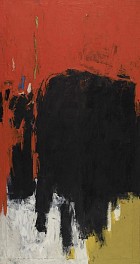BIOGRAPHY

American (1915-1996)
Edward Dugmore (1915-1996) was an American abstract expressionist painter with close ties to both the San Francisco and New York art worlds in the post WWII era. As one of Clyfford Still's most enthusiastic acolytes at the California School of Fine Arts in San Francisco, Edward Dugmore helped to define and expand the formal vocabulary of West Coast abstract expressionism.
Despite his eastern background-Dugmore was a native of Connecticut and lived in New York immediately after the war-his work was the antithesis of that of the New York-based "action painters" with its careful geometry and considered fields of color. In this sense, Dugmore's painting speaks more to the influence of Mark Rothko, who taught at CSFA in the late forties.
In 1952, Dugmore, after a brief period of living in Mexico, followed fellow CSFA graduates Ernest Briggs and Jon Schueler to New York and signed on with the influential Stable Gallery. During this period the artist's adherence to what curator and historian Susan Landauer has called "the San Francisco parched-earth aesthetic" reached its zenith. Dugmore experimented with the tension between positive and negative forms in his work, creating what art critic Clement Greenberg called the "pregnant void."
His work is in the permanent collection of several prominent museums including the Albright-Knox Art Gallery in Buffalo, the Corcoran Gallery in Washington D.C., the Hirshhorn Museum and Sculpture Garden in Washington, D.C., the Walker Art Center in Minneapolis, and the Menil Collection in Houston.
